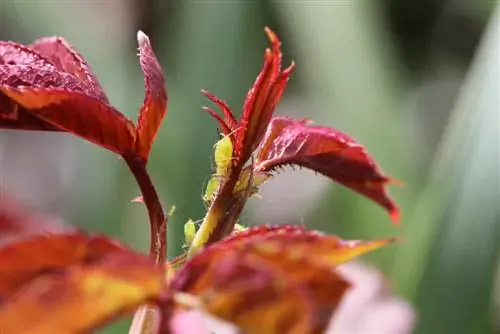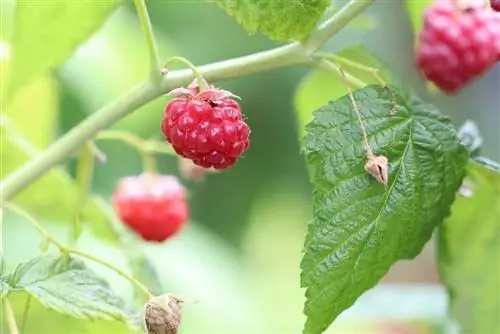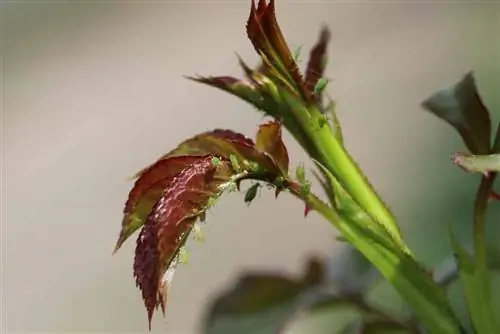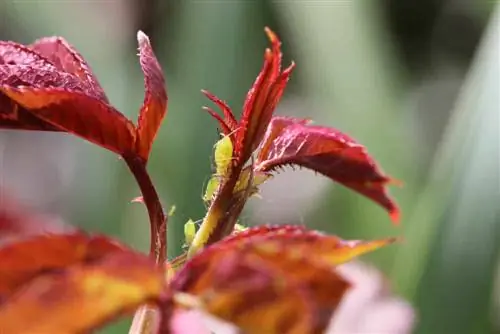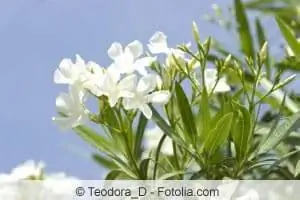- Author admin [email protected].
- Public 2023-12-17 03:39.
- Last modified 2025-01-24 12:45.
If plants weaken under unfavorable growing conditions, they also lose their resistance. And then they become easy prey for pests, e.g. B. for aphids, which really like both fruit vegetables.
Reasons for aphid infestation
The general weakness of the foreigners in our latitudes has already been mentioned. Aphids are very common in tomatoes and peppers during the cultivation stage. Freshly pricked young plants that have been additionally weakened by pricking are often attacked. Given the conditions with which these plants have to contend with in our country, the first question to be asked is whether pricking out these plants is a good idea at all.
If the seeds are planted individually in pots, you save them the shock of moving them, and after all, nature doesn't prick out. The main argument for pricking out is that you can plant the transplanted plants deeper so that they can develop additional roots at the end of the trunk, but this can also be achieved by piling them up.
Once the plants are larger, there are usually no longer many problems with aphids outdoors; tomatoes are then actually no longer particularly susceptible to aphid infestation. There are also natural enemies here doing their work. In the greenhouse or when growing under foil, however, there are more problems with aphids, so you should first try to correct any care errors. In addition to a lack of light, over-fertilization and poor ventilation can lead to deficiency symptoms; such errors should be corrected first.
Aphid control on peppers and tomato plants
Since the problem of aphid infestation occurs frequently on these plants, chemists have come up with a lot of ideas to provide plant protection products that can combat this plague. If the aphid infestation is already quite advanced, the use of pesticides can make sense.
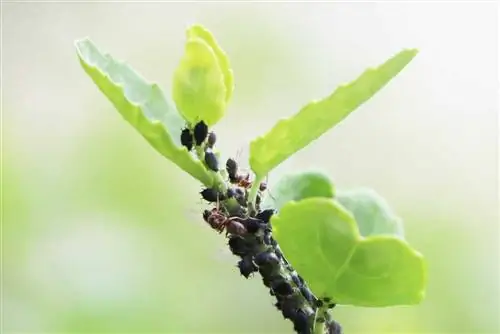
In the new Plant Protection Act, only products that want to combine high effectiveness with the lowest possible risk to people and the environment are permitted for home and allotment gardens. However, the prerequisite is that you only use the products that are approved for the respective plant and only apply the prescribed amounts of this product. There are some plant protection products that are approved for use in home and allotment gardens against aphids on tomatoes and peppers. These remedies contain a variety of active ingredients, from neurotoxins to agents that appear under the biological tips for aphid control:
- There are products with deltamethrin, a neurotoxin, which is only contained in the tiny amount of 0.008 grams in one liter of the pesticide.
- Other pesticides contain other toxic substances, such as pirimicarb, which is specifically effective against aphids (8.33 grams per liter) or thiacloprid (9 grams per liter), which can be used against a range of pests.
All of these products are also dangerous for bees. Deltamethrin may therefore be used outdoors on tomatoes and peppers from the time the first pair of leaves develop until the fruit is fully ripe, but expressly not during flowering. Pirimicarb and thiacloprid are generally limited to use in greenhouses or rooms, offices and balconies, where they must also not be applied to flowering plants or plants visited by bees.
For all three products there is a waiting period of 3 days between the last application and harvest. All of these agents are not harmless to humans, which is why, in addition to the application quantities, the special method of application, special prohibitions on application to bodies of water and all prescribed protective measures should also be taken into account.
Alternatives to industrial aphid poisons
Then there are products with different concentrations of potash soap that can be used outdoors and in greenhouses. Potash soap is simply soft soap in its purest form, which means that here you can find approved pesticides and biological agents recommended on the Internet against aphid infestation. In the light of the products approved for certain plants, you can then better assess other recommendations from the Internet:
For example, neem oil is also recommended on the Internet for use on tomatoes - the azadirachtin it contains works here. Products containing azadirachtin are available as plant protection products for home and small gardens, but they are not approved against aphids and are not approved for use on tomato plants. That makes perfect sense: Azadirachtin is broken down much more slowly in tomatoes than, for example, in tomatoes. B. in apples, neem does not kill the pests immediately, but only prevents the complete development of the offspring. That's why neem oil is usually far too mild for the initial treatment of aphids, which multiply very quickly. Another argument against the use of this active ingredient is that aphids quickly become resistant to neem if the agent is not used 100% correctly. This happens when it rains shortly after spraying neem, the azadirachtin does not water down or kill the lice, but they have just received the desensitizing dose that makes them resistant.
Combat aphids mechanically and biologically
If the aphid infestation is still very small and you actually refuse to chemically treat the plants from which you will eat the fruits, you could try biological-mechanical control. This means first: stripping off the aphids or showering them off, then the plants are (repeatedly) doused with a wormwood extract or with freshly prepared nettle liquid.
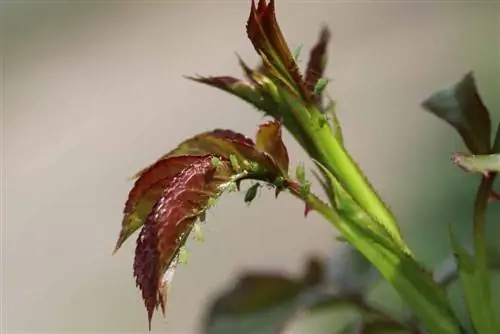
You could also use ladybirds, earwigs, hoverflies, parasitic wasps or gall midges. These natural enemies of lice destroy hundreds of aphids every day. You can simply buy the beneficial insects or collect them in the garden or attract them outdoors by planting yarrow or dill next to the tomatoes. You could make your own homes for earwigs, so-called earwig bells.
By the way, did you know that your tomatoes also eat the aphids themselves? Seriously: Tomatoes have hairs on the stem that catch the aphids, the tomatoes absorb the nutrients from the decaying animals. This has just been discovered, and therefore, according to the researchers, tomatoes should also be classified as carnivorous plants.

